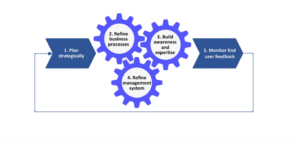Most forward-thinking companies invest in AI to improve their business operations by transforming insights. However, those investments are not consistently delivering the results the companies had envisioned.
A recent survey indicates that among the companies that have made some investment in AI, fewer than 2 out of 5 report business gains from their investment in the past three years. Per the survey, this number improves to 3 out of 5 when we include companies that have made significant investments. This still implies that 40% of organizations making significant investments in AI do not report business gains.
There are several reasons why companies are not achieving their expected return on their investments:
- Approach: Lack of clear strategy and understanding of what is achievable
- Design: Poor model design, data and governance issues, algorithm bias
- Implementation: Limited internal support for full implementation
- Trust: Lack of trust in the insights
- Action: Inability to translate insights to action
While all these inhibitors are critical, and any one of these reasons could derail the ROI in AI initiatives, I will focus on one of the most common and critical inhibitors: the inability to translate insights to relevant actions.
When designed well, AI systems can deliver valuable insights into your business operations and revolutionize your approach toward providing value to your customers and shareholders. However, if you don’t implement the right actions based on the insights, it can waste resources. You must align all relevant business operations with informed decisions based on the new insights.
The critical question business executives must be asking is: What are the right downstream behavior changes required to act on the insights? How do we manage the changes to ensure we are achieving desired results?
In order to determine the right actions, here is a method to consider:
1. Plan Strategically
Start with defining the current and desired state based on the new insights.
- What are the different operational units that are impacted or need to change behavior to achieve the desired end-state?
- Evaluate all value chain elements, including procurement, product development, marketing, sales, services, maintenance, etc.
- What are the specific behavior changes you expect from each business area?
- What are the desired overall outcomes?
- What are the steps to get there?
Develop an end-to-end plan across all relevant units with a clear change management process to implement.
2. Refine Business Processes
Once the relevant operational units are identified, using the end state as a base, define all relevant processes that are impacted. Evaluate broader cross-unit processes as well as processes within operational units. Consider customer journey and touchpoints as well as upstream and downstream activities.
Upstream activities could include the marketing process that results in the marketing outreaches. Downstream activities include tools and processes applied for the post-sales support processes. Refine and add new processes as required to achieve the end states. Consider change management approaches to ensure process changes are implemented correctly.
3. Build Awareness and Expertise:
Once the relevant operational units are identified and processes are refined, define (within each business operations area) who needs to change behavior. Consider both internal teams and external partners.
Once the right constituents are identified, determine the awareness and training required to implement the new processes and drive new behavior. Consider initial training and ongoing training requirements with more frequent training or refreshes until initial results are achieved. Ensure early learnings are being applied to refine training as required.
4. Refine Management System
An effective management system is critical to ensure that changes are being executed correctly to achieve desired results. Do we have the right operational metrics to get visibility to the operational changes? What are the leading indicators and the final business performance metrics?
Note that the final business metrics may not always be financial and could take the form of NPS scores, customer satisfaction metrics, increased frequency of customer touchpoints, etc. Are the targets realistic and staged appropriately for the near-term vs. long-term? Is the measurement frequency appropriate? Are the rewards and recognition systems aligned to provide compelling incentives?
5. Monitor End-User Feedback
It is essential to ensure a feedback loop with the end-user throughout the changes. Often there are unintended consequences.
A new process aimed at improving responsiveness to customer requirements with operational metrics focused on transaction efficiency could result in hurried customer conversations and impact satisfaction. A new incentive focused on new customer acquisition could drop an average deal size or subsequent sales if the incentives and management systems are not aligned correctly.
Ensuring ongoing end-user feedback will be critical to ensure that unintended consequences are highlighted quickly so you can take corrective actions quickly.
* * *

Learn how Pragmatic Institute can train your data team to deliver critical insights that power business strategy.
Author
-

Harish Krishnamurthy is president at Sciata and has held leadership roles across P&L, sales, marketing and strategy during his tenure at IBM, Insight Enterprises and Spear Education.









